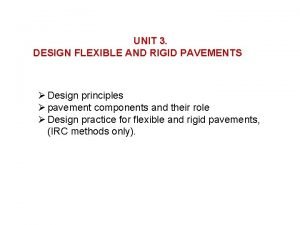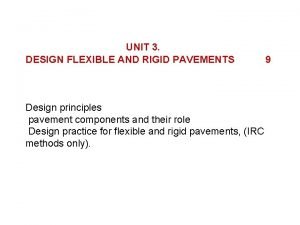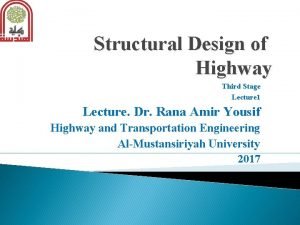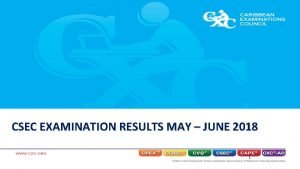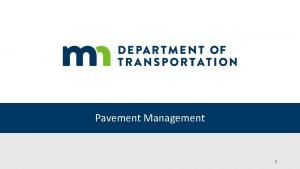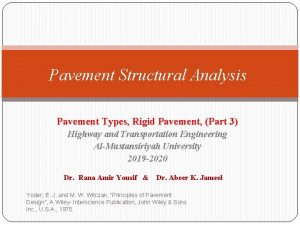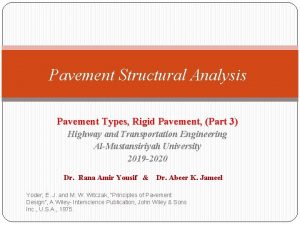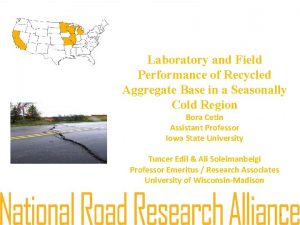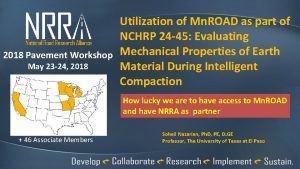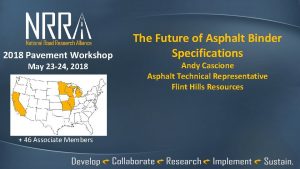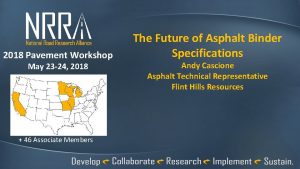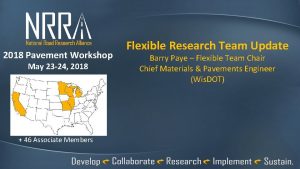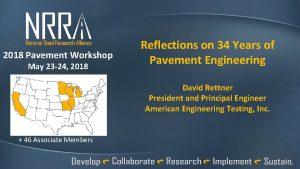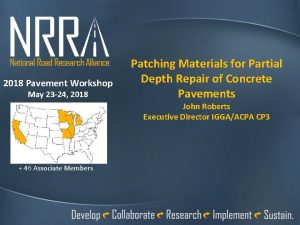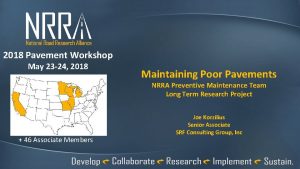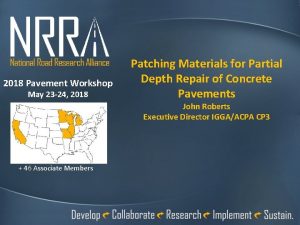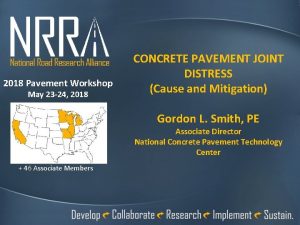2018 Pavement Workshop May 23 24 2018 The














- Slides: 14

2018 Pavement Workshop May 23 -24, 2018 The Future of Asphalt Binder Specifications Andy Cascione Asphalt Technical Representative Flint Hills Resources + 46 Associate Members 1

One Hundred Years Ago in 1918 • World War I officially ends with the Treaty of Versailles • US Congress approves time zones • The average middle class family makes $1, 500 per year • The Boston Red Sox win the World Series and trade Babe Ruth to the Yankees • The US Bureau of Public Roads develops penetration grades for asphalt

Evolution of Binder Specifications Penetration Grading Viscosity Grading 1963 1918 60/70 85/100 Performance Grading 1993 AC-10 AC-20 PG 58 -28 PG 64 -22 MSCR Testing ? 2010 The Future PG 58 H-28 PG 58 V-28

MSCR Test Development • Applies a larger stress to an asphalt sample in the DSR • Measures Jnr to characterize rutting resistance at the design traffic level • Measures % Recovery to ensure proper polymer networking and overall elastic behavior at the pavement temperature Grading System Based on Climate and Traffic PG 58 H - 28 Performance Grade Average 7 -day max pavement design temp Traffic Level Minimum pavement design temperature

Past “Temperature Bumps” 58°C (136°F) 64°C (147°F) PG 58 -28 n Standard traffic PG 64 -28 1 “Bump” n 70°C (158°F) PG 70 -28 2 “Bumps” Slow or heavy n Stationary or traffic high volume traffic

MSCR “Traffic Bumps” 58°C PG 58 S-28 PG 58 H-28 1 “Bump” n Heavy traffic PG 58 V-28 2 “Bumps” n Standard traffic n Very heavy traffic 58°C PG 58 E-28 3 “Bumps” n Extreme traffic

% Recovery AASHTO M 332 (Modified by CSBG) 100 90 80 70 60 50 40 30 20 10 0 Asphalt that plots above the line indicates the presence of an elastomeric network E V H AASHTO Recovery Curve S 0 0. 5 1 1. 5 2 2. 5 Jnr 3. 2 -1 k. Pa 3 3. 5 4 4. 5

Production Samples 2013 -2017 Asphalt Grade High PG % Recovery Average Lowest PG 58 -34 61. 8 58. 9 11. 8 PG 58 H-34 63. 3 59. 9 38. 1 PG 64 -34 66. 6 64. 4 43. 4 PG 58 V-34 67. 3 64. 0 60. 2 PG 64 -28 67. 2 65. 2 19. 8 PG 58 H-28 67. 6 65. 3 35. 8 Red values plot below AASHTO Recovery Curve

Polymer Modified Asphalt In a Fluorescence Microscope Partially Reacted Fully Reacted % R = 21. 0 %R = 46. 4 %R = 58. 3 Jnr = 0. 68 Pa-1 Jnr = 0. 39 Pa-1 Jnr = 0. 31 Pa-1 Unreacted 200 μm The % Recovery improves as the polymer develops a crosslinked network in the asphalt

Beyond MSCR: Current Research • NCHRP 9 -59 – Development of asphalt binder fatigue parameter • G* X Sin(δ) needs improvement • Replacement needs to relate binder fatigue to mixture fatigue • NCHRP 9 -60 – Impact of asphalt formulation and manufacture • Address poor quality asphalts that lead to low pavement durability & premature block cracking • NCHRP 9 -61 – Improve laboratory aging methods • Optimize RTFO and PAV procedures to simulate longer field aging times Fatigue & Cracking Tests Under Evaluation ‒ Delta. Tc ‒ SENB BBR ‒ Ex. BBR ‒ R-value ‒ Phase Angle ‒ Glover-Rowe ‒ LAS DSR ‒ Crossover Temp. ‒ Crossover Freq. ‒ DENT ‒ ABCD Other

Asphalt Binder Fatigue Testing • G*x Sinδ is highly variable (d 2 s% = 40. 2) • Test variability is greater than production variability • G* is the culprit, not phase angle (δ) • Current parameter can actually make asphalt binders more susceptible to fatigue damage • Glover-Rowe parameter demonstrates δ needs to be higher at intermediate temperatures, not lower, for stress relaxation and microcrack healing G* x Sin(δ)

Glover – Rowe (G-R) Parameter • 7. 50 7. 00 6. 50 Block Cracking 6. 00 Log G* 5. 50 (Pa) 5. 00 50 = 4 G-R one Z e ag Dam G-R ss k. Pa 0 18 = 4. 50 Lo In cr sin D of g. G Du ct R ilit y g a am k. Pa No Block Cracking 4. 00 ea ne o e. Z Asphalt ages in this direction 3. 50 0 10 20 30 40 50 60 Phase Angle 70 80 90

Delta Tc (ΔTc) – Age Related Cracking BBR Results for Gulf-Southeast Asphalt • ΔTc = Stiffness Low PG – m-value Low PG • Asphalts < -5 could be prone to cracking • Some asphalts have a low ΔTc • Waxes, REOB, paraffinic crudes • Leads to physical hardening, cracking • Testing time and variability? Temperature, C • As asphalt ages, it becomes more mcontrolled and loses it’s ability to relax stresses - ΔTc -10. 0 -20. 0 Tc (Stiffness) -30. 0 Tc, (m-value) -40. 0 0 20 40 60 PAV Aging Time, Hrs From AAPT 2011; M. Anderson, et al 80

Thank You
